Flora Ginn
![You can judge a book by its cover : a brief survey of materials [Ginn, Flora] You can judge a book by its cover : a brief survey of materials [Ginn, Flora]](http://omeka.wustl.edu/omeka/files/fullsize/3212e232112a1ffc6227fa9401903357.jpg)
Bound in full leather with gilt onlays; spine lettered in gold; leather doublures; gilt edges; in a leather drop-spine box.
Geraty writes, “Since I was a child I have made things. Throughout school, for reasons unclear at the time, I felt no affinity for the conventional work world. So, near the end of college when I had the chance to set type, print books and bind them for a small press, I knew I had found something that had meaning for me. It’s been twenty-one years now and I can safely say that my instincts were right. Bookbinding, is at its root the manipulation of materials and the solving of problems. Each work experience I have had has given me an insight into both of these aspects and added immensely to my appreciation of the beauty and nobility of the craft. The trajectory of my training had been toward the conservation field, as well as, edition and fine binding. Most important to that was the year and a half I worked at the Museum of Comparative Zoology at Harvard University and the four and a half years at the Harcourt Bindery in Boston. My work at the museum introduced me to many important and beautiful books and the need for preserving them. Harcourt Bindery was the place where I learned many of the skills, speed and accuracy necessary to reach my goals.”
“I began my own bindery in 1984 in the Boston area and moved to its present location in 1985. Several years ago I changed the name to the bindery from Peter Geraty Bookbinding and Restoration to Praxis Bookbindery. The word praxis best defines my approach to bookbinding. It is the practice or exercise of a skill. For me, it is the doing again and again always trying to do it better. It is what drives me and along with appreciation of the finished book, it is the pleasure I receive from the craft.”
BINDING
“The binding I have sent to you, as well as the chemise and slipcase, has been covered in green pebble grained goatskin. The doublures, flyleaves and lining for the chemise are hand-dyed silk. The edge is full solid gilt and gauffered with handmade tools cut to resemble broken eggshell. The decoration on the covers is gilt eggshell. As a decorative medium I have always been intrigued with it because of the random broken outline. The mosaic possibilities are probably limitless. Since it was one medium Mr. Middleton did not mention I thought the time was ripe for me to finally try it. This design was easier than some because there was no underlying meaning to the text. The subject of the book left one open to experiment and play. When designing covers for books of poetry, essays or a novel I feel it is important to try to find the essence of the author’s message. I take that essence and translate it through my voice with the expectation that I can embellish the text much the way an illustrator does. I have found the making of my own finishing tools, or in this case gauffering tools, gives me a freedom from the constraints of gouges and pallets with their uniform line quality. I like the more spontaneous nature that arise from the use of these tools in combination with unusual techniques or materials.”
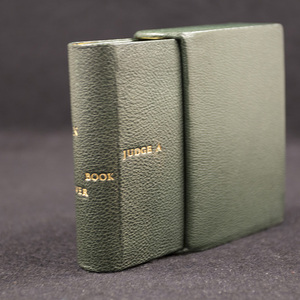
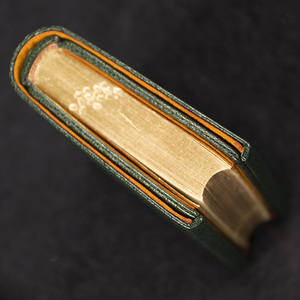
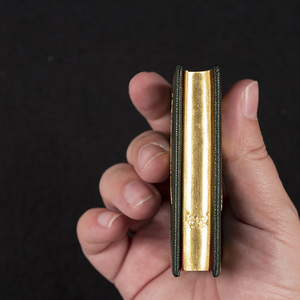
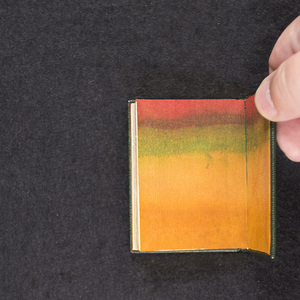
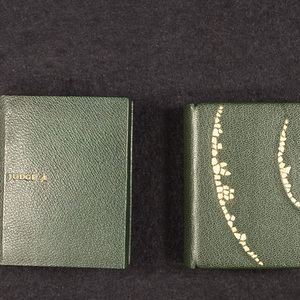
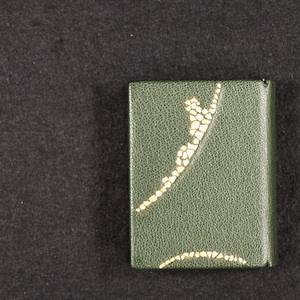
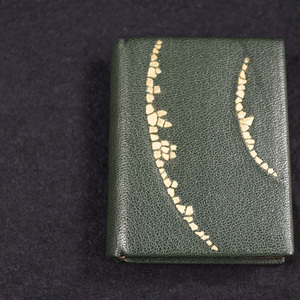
Born in 1959 in Hong Kong, Ginn studied graphic arts (specializing in calligraphy) at City and Guilds of London Art School during 1978 to 1982. She studied bookbinding and calligraphy at Digby Stuart College in Roehampton from 1982 through 1984. A further two years, (1984-86) were spent , part-time, specializing in fine binding under Jen Lindsey and Denise Lubett at Digby Stuart College. Evening classes under Sally Lou Smith at the Stanhope Institute, London, were also undertaken during this same period. In 1986 Bernard Middleton took her on as a part-time trainee/assistant in restoration work, where she worked with him for twelve years. It was also at this time that she set up her own bindery in London. Elected a Fellow of Designer Bookbinders in 1990, she took up part-time teaching in 1994 at the City Literary Institute in London.
BINDING
Flora Ginn said in 1998, “During the past ten years that I have been working for my master Bernard Middleton, and due in great part to his encouragement and support, I have gained knowledge and insight into the structure of books, but of course I still have much to learn. My forwarding techniques are based on traditional methods which provide sound structures, and the materials I use are of the best available quality. My designs are generally related to the contents of the book. The colour scheme plays an important part, so I often use onlays for colour contrasts, combined with gold tooling which can be used to create highlights, a technique which I find to be very inspiring. I am very much involved in the restoration of antiquarian books, so I have had the privilege of handling many beautiful bindings of all periods, many of which were finely gold tooled. This experience has certainly fueled my interest in tooling and the many ways it can be exploited. Although I have had no formal training in finishing, I have learned a great deal by observing Bernard Middleton at close hand, particularly in respect of the handling and use of finishing tools. The practice of the crafts of fine bindings and book restoration plays a large part in my life and gives me enormous pleasure.”








